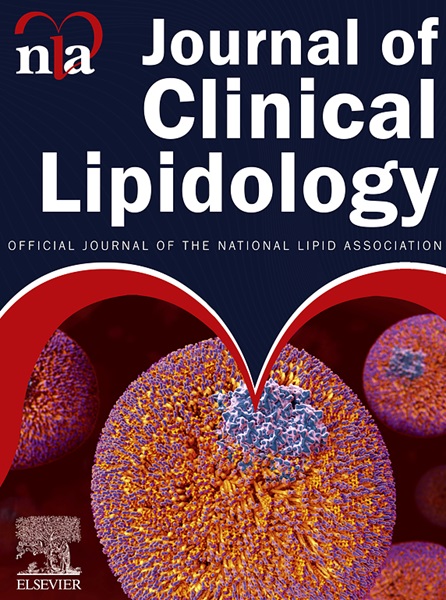Triglyceride-rich lipoprotein sphingolipids are altered in primary hypertension: A pilot case-control study
IF 3.6
3区 医学
Q2 PHARMACOLOGY & PHARMACY
引用次数: 0
Abstract
BACKGROUND
Sphingolipids modulate vascular function and alterations in plasma sphingolipid profiles have been associated with hypertension. Plasma sphingolipids, such as ceramides (Cer) and sphingosine-1-phosphate (S1P), are predominantly carried by lipoproteins.
OBJECTIVE
We compared sphingolipid profiles in plasma and isolated lipoproteins of patients with primary hypertension with those of normotensive controls.
METHODS
Blood was obtained from 19 patients with hypertension and 19 age- and sex-matched normotensive controls. S1P and the 7 most abundant Cer were quantified by liquid chromatography-tandem mass spectrometry in plasma and in lipoproteins.
RESULTS
Total plasma Cer were significantly higher in patients with hypertension compared to controls (14.3 ± 1.0 vs 11.9 ± 0.7 µM; P = .047), while there were no differences in plasma S1P levels (1.8 ± 0.1 vs 2.1 ± 0.1 µM; P = .128). Total Cer carried by patient triglyceride-rich lipoproteins (TRL; ie, predominantly very low-density lipoproteins) were also significantly higher (1.33 ± 0.15 vs 0.58 ± 0.10 µM; P = .001), which held for all Cer tested. Systolic blood pressure positively correlated with plasma levels of Cer(d18:1/20:0), and Cer(d18:1/24:1), and diastolic blood pressure positively correlated with total Cer, Cer(d18:1/18:0), Cer(d18:1/20:0) and Cer(d18:1/24:0). Relative to plasma Cer(d18:1/24:0), levels of Cer(d18:1/18:0), Cer(d18:1/20:0), and Cer(d18:1/24:1) were significantly higher in patients with hypertension than in controls.
CONCLUSION
Patients with hypertension display higher plasma Cer levels than normotensive controls, which is mainly explained by elevated concentrations in TRLs. Cer levels positively correlate with systolic and diastolic blood pressure, and ratios of Cer relative to Cer(d18:1/24:0) suggest an increased cardiovascular risk.
富甘油三酯脂蛋白鞘脂在原发性高血压中发生改变:一项试点病例对照研究
背景:鞘脂调节血管功能,血浆鞘脂谱的改变与高血压有关。血浆鞘脂,如神经酰胺(Cer)和鞘氨醇-1-磷酸(S1P),主要由脂蛋白携带。目的:比较原发性高血压患者与正常血压对照组的血浆和分离脂蛋白鞘脂谱。方法:采集19例高血压患者和19例年龄、性别匹配的血压正常者的血液。采用液相色谱-串联质谱法测定血浆和脂蛋白中的S1P和7个最丰富的Cer。结果:高血压患者血浆总Cer明显高于对照组(14.3±1.0 vs 11.9±0.7µM;P = 0.047),血浆S1P水平差异无统计学意义(1.8±0.1 vs 2.1±0.1µM;P = .128)。患者富甘油三酯脂蛋白(TRL)携带的总Cer;(主要是极低密度脂蛋白)也显著增加(1.33±0.15 vs 0.58±0.10µM;P = .001),这对所有测试的Cer都成立。收缩压与血浆Cer(d18:1/20:0)、Cer(d18:1/24:1)呈正相关,舒张压与总Cer、Cer(d18:1/18:0)、Cer(d18:1/20:0)、Cer(d18:1/24:0)呈正相关。相对于血浆Cer(d18:1/24:0),高血压患者的Cer(d18:1/18:0)、Cer(d18:1/20:0)和Cer(d18:1/24:1)水平均显著高于对照组。结论:高血压患者血浆Cer水平高于正常对照组,这主要与trl浓度升高有关。Cer水平与收缩压和舒张压呈正相关,Cer与Cer的比值(d18:1/24:0)表明心血管风险增加。
本文章由计算机程序翻译,如有差异,请以英文原文为准。
求助全文
约1分钟内获得全文
求助全文
来源期刊
CiteScore
7.00
自引率
6.80%
发文量
209
审稿时长
49 days
期刊介绍:
Because the scope of clinical lipidology is broad, the topics addressed by the Journal are equally diverse. Typical articles explore lipidology as it is practiced in the treatment setting, recent developments in pharmacological research, reports of treatment and trials, case studies, the impact of lifestyle modification, and similar academic material of interest to the practitioner.
Sections of Journal of clinical lipidology will address pioneering studies and the clinicians who conduct them, case studies, ethical standards and conduct, professional guidance such as ATP and NCEP, editorial commentary, letters from readers, National Lipid Association (NLA) news and upcoming event information, as well as abstracts from the NLA annual scientific sessions and the scientific forums held by its chapters, when appropriate.

 求助内容:
求助内容: 应助结果提醒方式:
应助结果提醒方式:


